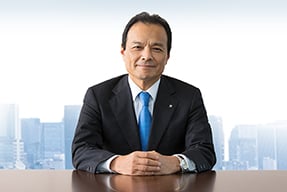Described below is the summary of Q&A session with institutional investors and securities analysts at the FY2014 3Q results conference call held on February 13, 2015.
- Q1If we look at the three-month results of TMNF in 3Q (October to December), underwriting profit has decreased compared with its trend until 2Q FY2014. This appears to be the case even if we exclude the impact of the increase in net provision for catastrophe loss reserves. Can you explain the reason for this?
- A1
One of the factors for the decrease in underwriting profit from 2Q to 3Q was an increase in net provision for catastrophe loss reserves. Since most of the outstanding claims related to the snowstorms in February 2014 have been paid in 1Q FY2014, the amount taken down from catastrophe loss reserves tends to be greater in the first half of FY2014 with gradual decrease of the impact onwards in the second half of FY2014. The decrease in underwriting profit excluding the impact of catastrophe loss reserves was mainly due to an increase in net incurred losses relating to natural catastrophes occurred in 3Q (October-December).
- Q1(2)E/I loss ratio excluding natural catastrophes also worsened from 56.1% in 2Q to 58.4% in 3Q. What is the reason behind this?
- A1(2)
In addition to the impact of a major accident in fire and an increase in the number of small- and medium-sized accidents in marine, the seasonal factors in auto were among the worsening factors.
- Q2Adjusted earnings of international insurance business was 107 billion yen as of the end of 3Q, making a steady progress toward its full-year projections of 120 billion yen (as announced in November 2014). Moreover, adjusted earnings in Europe, Asia, and reinsurance businesses have already exceeded the full-year projections. Please explain the reasons behind this favorable progress in each business.
- A2
Regarding Europe and reinsurance businesses, the main reason for their favorable progress was the number of natural catastrophes fewer than projected. In addition, an increase in foreign exchange gains, associated with the appreciation of the dollar to the pound, was another factor for the profit growth in Europe. In Asia, the growth factors included a special factor in Singaporean non-life business (a decrease in corporate tax) and improved underwriting results mainly in Malaysia.
- Q3I think the accounting period for overseas subsidiaries is already closed at the end of December 2014. How do you expect their full-year results?
- A3
Since the FX rate as of the end of September 2014 was applied for the calculation of full-year projections announced in November (120 billion yen), the progress of the depreciation of the yen from October through December was one of the factors that can push up the profit to exceed our projections. In addition, the fewer-than-projected natural catastrophes in 3Q (July-September) and the absence of large scale natural catastrophes in 4Q (October-December) can also be such factors. The full-year results are yet to be calculated at present, and will be announced when the full-year results of FY2014 is disclosed.
- Q4TMNF's combined ratio seems to be on a quite favorable trend with the 3Q result of 90.1%, much better than its full-year projection of 94.2% (private insurance on W/P basis). Based on this, I think the combined ratio may fall below the full-year projections. What do you expect for the figure at the end of FY2014?
- A4
Since the auto loss ratio in 3Q has been better than the full-year projections, we think that there is a possibility of TMNF's combined ratio (private insurance total) falling below our full-year projections.
- Q5How do you forecast the direction of TMNF's combined ratio in FY2015? Considering the fact that the effect of rate revisions implemented in the past is to be realized also in and after FY2015, do you expect further improvement?
- A5
Although there are improving factors as you have mentioned, there are also worsening factors such as an increase in unit repair cost. In such a situation, we will work to steadily maintain a combined ratio of 95% or below by further improving our business efficiency.
- Q6At present, there is a sharp decline in interest rates. Is there any impact on sales of your life business?
- A6
Up to 3Q FY2014, there was no change in the top-line trend of our domestic life business. Although some major life insurance companies are reported to be suspending the sales of single premium policies, there is no material impact on TMNL, because it has already suspended its sales of endowment and annuity with single premium.
- Q7There is a large difference between the amount of provision for catastrophe loss reserves in 3Q (42.4 billion yen) and its full-year projections announced in November (4 billion yen). Given the recent situations, what amount should we expect at the end of FY2014?
- A7
The reason for the increase in provision for catastrophe loss reserves was the W/P loss ratio falling below our full-year projections announced in November. Based on the recent situations including auto loss ratio, although we cannot disclose specific figures, the amount of provision is likely to be larger than the full-year projections.
- Q8The increase in provision for catastrophe loss reserves should be a negative factor for TMNF's financial results compared with its full-year projections. On a consolidated basis, are there any positive factors to offset this?
- A8
After consideration of each positive and negative factor, we decided not to revise our full-year projections this time. Specifically at TMNF, provision for catastrophe loss reserves are likely to increase, however, there are positive factors including reduction of business expenses greater than projected and natural catastrophes fewer than projected. Also, in the international insurance business, the depreciation of the yen and the fewer-than-projected natural catastrophes will push up the profit to exceed the full-year projections. However, when the decrease in corporate tax is determined, reduction of deferred tax assets will be a negative factor, which is not factored into our current full-year projections.
- Q9According to your explanation, TMNF's combined ratio may turn out better than your full-year projections. Please give us your comments on TMNF's loss ratio and expense ratio.
- A9
As I have explained earlier, we expect TMNF's loss ratio to be better than our full-year projections, mainly due to improvement in auto. Expense ratio is also expected to fall below our full-year projections due to further reduction of non-personnel expenses.
- Q10At TMNL, the provision for underwriting reserves was a factor to decrease its profit. How much was its impact? Was it factored into your full-year projections announced in November? Will it happen again in the future?
- A10
The provision for underwriting reserves was approximately 6 billion yen, which was factored into our full-year projections. Going forward, we will continue to make decisions considering the market environment.
- Q11One of the positive factors for the European business was the foreign exchange gains associated with the appreciation of the dollar against the pound. How much was the foreign exchange gains? Also, is my understanding correct that foreign exchange gains will be recorded also in 4Q as the dollar continues to appreciate against the pound in and after September?
- A11
The foreign exchange gains recorded in 3Q was approximately 2 billion yen (after tax). Similar trend is likely to continue in 4Q in light of the exchange rate environment in and after September, although we are in the process of calculating the amount of gains in 4Q.
- Q12At present, there is a softening trend in the North American market. Please explain the reasons behind the revenue growth in your North American business.
- A12
Top-line increased by 6% YoY even excluding FX effects mainly due to rate increases at Philadelphia and Delphi. This robust growth trend is expected to continue.
- Q13TMNF saw a large increase in dividends from overseas subsidiaries in this quarter. Will this be the case in every 3Q going forward?
- A13
In FY2014, some overseas subsidiaries paid dividends in 3Q, but the timing of dividend payments in and after FY2015 is not yet determined. Although the dividend level is on an upward trend due to the depreciation of the yen and continued profit growth, it may change in and after FY2015 because dividends from some subsidiaries increased in FY2014 due to factors specific to this fiscal year.
- Q14Please explain the policy of dividend payments by overseas subsidiaries.
- A14
Dividends from group subsidiaries are to be paid using a calculation standard based on our capital cost.
These information materials are prepared based on the currently available information for us and described subject to our predictions and forecasts carried out at the time of preparation.
It must be noted that what is described therein does not guarantee our future business performance and carries certain risk of misjudgment or uncertainty.
Accordingly, you are kindly requested to bear in mind that there may be a possibility of sizable divergence between the actual business performance in the future and that of our predictions or forecasts described therein.





